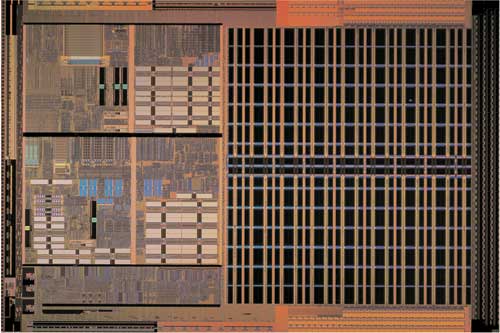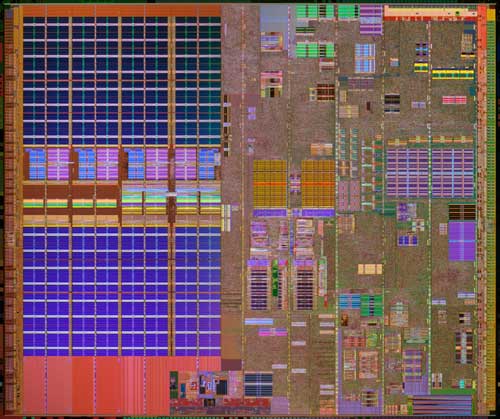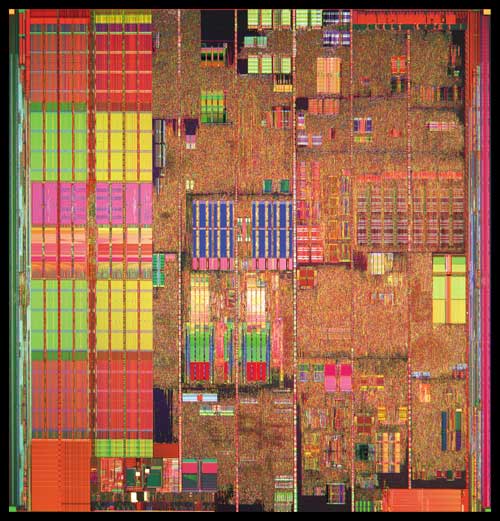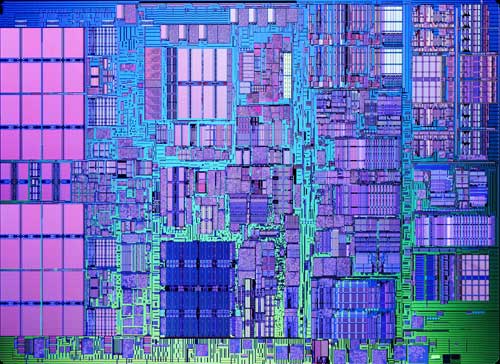Intel Pentium 4 6xx and 3.73EE: Favoring Features Over Performance
by Anand Lal Shimpi & Derek Wilson on February 21, 2005 6:15 AM EST- Posted in
- CPUs
An Interesting Observation: Prescott 2M's Die
What has been true for a number of modern day microprocessors is that the vast majority of the CPU is made up of cache, take a look at the Athlon 64 FX with its 1MB L2 cache:

AMD Athlon 64 FX die (the large block to the right is its 1MB L2 cache)
Over half of the die is L2 cache.
But when looking at the new Prescott 2M core the same can't be said:

Intel Pentium 4 600 series die (the large block to the left is its 2MB L2 cache)
The split between logic and cache is almost 50/50, looking back at the original Prescott we see that the Prescott core itself actually occupied more die area than the cache:

Intel Pentium 4 500 series (the block to the left is its 1MB L2 cache)
There are two explanations for the phenomenon, first with Prescott Intel introduced their highest density cache ever produced; at present day it holds the record for largest cache with the smallest area on a modern desktop microprocessor. Secondly, is the fact that Prescott, with its 31 pipeline stages, 64-bit execution units and highly accurate branch predictors with massive branch history tables, is simply a big, complex core. Also remember that the Athlon 64 is basically a reworked K7 core, with wider execution units and datapaths, as well as an on-die memory controller, so it is understandably simpler.
Let's compare that to the Pentium M:

Intel Pentium M 90nm (the large block is its 2MB L2 cache)
The PowerPC 970 (used in Apple's G5 systems) looks a bit more Prescott like, but remember we're only dealing with a 512KB L2 cache here:

IBM PowerPC 970 (the block to the left is its 512KB L2 cache)
Or, even more interestingly, compare it to the newly announced Cell processor:

IBM/Sony/Toshiba Cell microprocessor (we apologize for the quality of the die shot, it's the best we could find)
Looking at Cell is quite interesting because it appears to be just as complex as Prescott, but remember that with Cell we're looking at 9 individual processors. But more on that next week...
Extreme Edition - Not so "Extreme" Anymore
Back when the Extreme Edition was first launched, the Pentium 4 had a "meager" 512KB L2 cache compared to the EE's 2MB L3 and 512KB L2. Now that the Pentium 4 has a 2MB L2 cache and is based off of the same core as the EE, the only benefit that the Extreme Edition offers is 1066MHz FSB support and a slightly higher clock speed.
We looked at the impact of the 1066MHz FSB in the past and quickly found that it didn't do much for the EE. Although we're now running at 3.73GHz for the Pentium 4 Extreme Edition, the benefit from the 1066MHz FSB is still pretty limited.
As for the clock speed advantage, the fastest Pentium 4 6xx is the 660, running at 3.60GHz - 96.4% of the clock speed of the 3.73GHz Extreme Edition - the clock speed difference is effectively nothing.
But the price? The 3.73 EE will retail for $999, the Pentium 4 660: $605. The Extreme Edition was never a good value, but in the case of the new chip, it's basically throwing money away. Let the benchmarks speak for themselves, but your best bet is to wait for the next generation of Extreme Edition CPUs, either with a 4MB L2 cache or the dual core offerings.










71 Comments
View All Comments
KingofL337 - Tuesday, February 22, 2005 - link
Why would anyone buy a P4 for EMT64? When AMD64 isa full implementations of 64 not just a poor incomplete copy?
In Soviet Russia, Computer Reboot You!
Zebo - Tuesday, February 22, 2005 - link
"The original Prescott was a Sunday launch. "Well see what I mean..:)
Hans Maulwurf - Tuesday, February 22, 2005 - link
And remember hyperthreading - it uses only a small area on the die and increases power consumption significantly!Oh, and I would still like to know weather it ws 1T or 2T on the Athlon.
Viditor - Tuesday, February 22, 2005 - link
Reflex - First, you may very well be quite correct!Second, not all parts of the die are equal...for example, the ALU runs at twice the clockspeed of the core. The areas affected by 64bit modes MAY be disproportionally higher than the rest of the CPU (I really don't know, which is why I'm asking for a test...).
Third, the design for 64bit on Intel is quite different that on AMD. AMD designed the chip to be hybrid from the ground up, Intel had to "retrofit" their Netburst architecture to accomodate it...while they both function very similarly, their incorporation into the chip is quite dissimilar (e.g. AMD has no double-pumped ALU)
DerekWilson - Monday, February 21, 2005 - link
Intel often does sunday launches --The original Prescott was a Sunday launch.
And there was at least a couple others that I can't recall at the moment.
I've seen other sites say something to the affect of this being a sneaky launch, and I think don't think that is accurate.
I, for one, would prefer Intel not launch parts on a Sunday. But that's how its been and likely how it will be. :-/
Zebo - Monday, February 21, 2005 - link
What's up with Intel sneaking around in the dark for..Sunday night launches on a holiday weekend told me all I needed to know about this new chip release.In sure they still sell billions over AMD but the message is clear from enthusiasts prosective. If you want performance, quiet and cool you buy AMD A64's.(ageing I might add)
johnsonx - Monday, February 21, 2005 - link
In Soviet Russia, message clears YOU!damn, it's hard to stop....
johnsonx - Monday, February 21, 2005 - link
The message is clear: Soviet Russia has failed.Enough already... let's move on to the next catch phrase (if there must be a next one...).
Reflex - Monday, February 21, 2005 - link
Vidiator - 64bit uses very little die space, even once activated its not going to consume any really noticable amount of power. On an Athlon64 its estimated to be about 10% of the core. Considering how much larger a P4 core is it would account for even less percentage wise. I am not including cache in that measurement either which as you saw accounts for 50% or better.So technically it may draw a watt or two, but its not going to change the results significantly...
Viditor - Monday, February 21, 2005 - link
danidentity - "Power consumption is not going to change depending on whether you're running 64-bit apps or not"Is there a reason you expect this? My own rationale is that Intel (I'm assuming here) probably dials down a few things (ALU logic, BISTs, unneeded repeaters, etc...) unless the CPU is operating in 64bit only mode or compatiblity mode (as opposed to legacy mode).
As an example, AMD64 doesn't use the extra registers unless it's in one of the 64bit modes...
I don't know if there will be a swing in power consumption, but I am curious to see any empirical evidence one way or the other...
Derek - Thanks for the heads up on the test (Powernow usage...)!